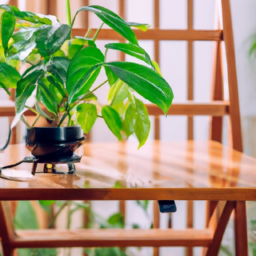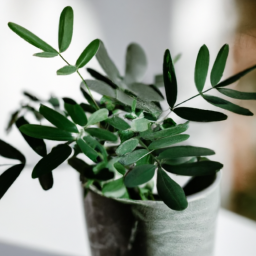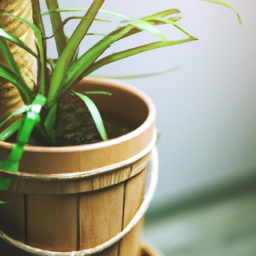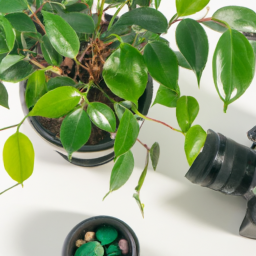
So you’ve been nurturing your indoor plants with love and care, and now you’re wondering, “When can indoor plants go outside?” Well, you’ve come to the right place! As the seasons change and the weather starts to warm up, many plant enthusiasts find themselves contemplating the perfect time to transition their beloved indoor plants to the great outdoors. In this blog post, we will explore the factors to consider and the steps to follow when deciding when it’s safe and beneficial to move your indoor plants outside. Whether you’re a seasoned plant parent or just starting your green thumb journey, let’s dive into the exciting world of taking your indoor plants on an outdoor adventure!
Benefits of Moving Indoor Plants Outside: Exploring the advantages of transitioning indoor plants to an outdoor environment
Indoor plants not only add beauty and freshness to our living spaces but also provide numerous health benefits. However, there comes a time when these plants outgrow their indoor habitats and yearn for the great outdoors. Moving indoor plants outside can be a transformative experience for both the plants and the plant enthusiast. In this article, we will explore the benefits of transitioning indoor plants to an outdoor environment, providing you with a step-by-step guide on when and how to make this transition.
Improved Growth and Vigor
One of the primary benefits of moving indoor plants outside is the improved growth and vigor they experience. While indoor conditions can be controlled to some extent, they often fall short compared to the natural environment. Outdoor plants receive an abundance of natural light, fresh air, and fluctuating temperatures, which stimulate growth and strengthen their overall health. The exposure to natural sunlight also enhances the production of chlorophyll, the pigment responsible for photosynthesis, resulting in greener and more vibrant foliage.
Additionally, outdoor plants benefit from the presence of beneficial insects, such as bees and butterflies, which aid in pollination. This natural interaction with the environment encourages the plants to develop stronger root systems and better adaptability, making them more resilient to pests and diseases.
When moving indoor plants outside, it is important to acclimate them gradually to the outdoor conditions. Start by placing them in a shaded area for a few hours a day, gradually increasing the exposure to sunlight over a period of two weeks. This will help them adjust to the intensity of outdoor light and prevent sunburn or shock.
Increased Air Quality
Indoor plants are known for their ability to purify the air by removing harmful toxins and releasing oxygen. However, when placed outside, they can have an even greater impact on air quality. Outdoor plants have access to a larger volume of fresh air, which allows them to absorb more carbon dioxide and release more oxygen. This natural air filtration system not only benefits the plants themselves but also improves the overall air quality in their vicinity.
Moreover, outdoor plants can help reduce the levels of indoor air pollutants. By placing them near open windows or doors, they can act as a natural filter, absorbing pollutants from the air before it enters your home. This can be particularly beneficial for individuals who suffer from respiratory conditions or allergies.
When moving indoor plants outside, it is essential to choose an appropriate location that provides good air circulation. Avoid placing them in areas with stagnant air or near sources of pollution, such as busy roads. Additionally, make sure to check the specific requirements of each plant, as some may prefer more sheltered spots while others thrive in open areas.
Enhanced Aesthetic Appeal
Indoor plants are often chosen for their aesthetic appeal, and moving them outside can take their beauty to a whole new level. Outdoor spaces offer a larger canvas for creativity and allow plants to reach their full potential in terms of size and form. Whether you have a small balcony, a backyard garden, or a spacious patio, incorporating indoor plants into your outdoor design can create a visually stunning and harmonious environment.
Furthermore, outdoor plants can be combined with other elements such as flowers, shrubs, or decorative features to create captivating landscapes. The contrast between the lush green foliage of indoor plants and the vibrant colors of outdoor flowers can create a mesmerizing visual impact.
When moving indoor plants outside for aesthetic purposes, consider their specific light requirements and choose a location that provides the optimal conditions for their growth. Some plants may thrive in full sun, while others prefer partial shade. Take into account the overall design of your outdoor space and choose plants that complement the existing elements.
In conclusion, moving indoor plants outside offers a multitude of benefits, including improved growth and vigor, increased air quality, and enhanced aesthetic appeal. By following the step-by-step guide provided in this article, you can ensure a successful transition for your beloved indoor plants. Remember to acclimate them gradually, provide proper air circulation, and consider their specific light requirements. So, why not give your indoor plants the opportunity to thrive in the great outdoors and enjoy the many advantages it brings?

Factors to Consider Before Moving Indoor Plants Outside
When it comes to moving indoor plants outside, there are several factors that need to be considered in order to ensure a successful transition. Temperature, light exposure, and acclimatization are three important factors that play a crucial role in determining when and how indoor plants can be relocated outdoors. Let’s take a closer look at each of these factors and understand how they impact the process of moving indoor plants outside.
Temperature
Temperature is one of the most critical factors to consider before moving indoor plants outside. Plants have specific temperature requirements, and sudden changes in temperature can shock or even kill them. It’s important to wait until the outdoor temperature is consistently within the range suitable for your plants.
Before moving your indoor plants outside, it’s recommended to check the hardiness zone for your area. The hardiness zone provides information about the average minimum winter temperature in a specific region. This information will help you determine if the outdoor temperature is suitable for your plants.
Additionally, it’s crucial to consider the temperature fluctuations during the day and night. Some plants may not tolerate extreme temperature changes, especially during the transition period. Gradually exposing your plants to outdoor temperatures by placing them outside for a few hours a day and gradually increasing the duration can help them acclimate to the new environment.
Light Exposure
Light exposure is another important factor to consider before moving indoor plants outside. Indoor plants are accustomed to a controlled environment with artificial lighting, and sudden exposure to direct sunlight can cause sunburn and damage the plant’s foliage.
Before relocating your plants outside, it’s essential to assess the amount of sunlight they will receive in their new location. Some plants require full sun, while others prefer partial shade. Understanding the light requirements of your plants will help you choose an appropriate spot in your outdoor space.
When moving your indoor plants outside, it’s advisable to start with a shady area and gradually expose them to more sunlight over a period of days or weeks. This gradual transition will allow the plants to adjust to the increased light intensity and prevent any sun damage.
Acclimatization
Acclimatization is the process of helping your indoor plants adjust to the new outdoor environment. Moving plants from a controlled indoor environment to the unpredictable outdoors can be stressful for them. Therefore, it’s crucial to acclimate your plants gradually to minimize the shock.
Start by placing your plants outside for a short period of time, such as a few hours a day, and gradually increase the duration over the course of a week or two. This gradual exposure will allow the plants to adapt to the changes in temperature, light, and humidity.
During the acclimatization process, it’s important to closely monitor your plants for any signs of stress or damage. If you notice any wilting, yellowing leaves, or other signs of distress, it’s best to bring the plants back indoors and adjust the acclimatization schedule accordingly.
It’s worth mentioning that not all indoor plants are suitable for outdoor conditions. Some plants are more sensitive and may not thrive outside. Before making the decision to move your indoor plants outside, research the specific requirements of each plant and determine if they are suitable for outdoor cultivation.
In conclusion, before moving your indoor plants outside, consider the factors of temperature, light exposure, and acclimatization. Pay attention to the temperature requirements of your plants, assess the light conditions in your outdoor space, and gradually acclimate your plants to the new environment. By taking these steps, you can ensure a successful transition and enjoy the beauty of your indoor plants in an outdoor setting.

When Can Indoor Plants Go Outside
Introduction
Bringing your indoor plants outside can be a great way to give them a breath of fresh air and allow them to soak up the natural sunlight. However, it’s important to ensure a smooth transition for your plants to prevent any shock or damage. In this guide, we will provide you with practical tips on when and how to successfully transition your indoor plants to the outdoors.
Understanding Your Plants’ Needs
Before you rush to move your indoor plants outside, it’s crucial to understand their specific needs and requirements. Different plants have different tolerances to temperature, light, and humidity. Here are some key factors to consider:
1. Light Requirements
Indoor plants are accustomed to lower light conditions compared to their outdoor counterparts. When transitioning them outside, it’s important to choose a spot that offers the right amount of light for each plant. Some plants may prefer partial shade, while others thrive in direct sunlight. Gradually expose your plants to increasing amounts of sunlight over a few days to help them adjust.
Keep in mind that intense midday sun can scorch delicate leaves, so providing some shade during the hottest part of the day can be beneficial.
Monitor your plants closely during this transition period. If you notice signs of sunburn, such as wilting or yellowing leaves, move them to a shadier spot or provide some protection, like a sheer curtain or shade cloth.
2. Temperature Considerations
Indoor plants are accustomed to stable temperatures inside our homes, so sudden temperature changes can be a shock to their system. It’s important to wait until the outdoor temperatures are consistently within the appropriate range for each plant.
Most indoor plants prefer temperatures between 60-75°F (15-24°C). However, some tropical plants may require higher temperatures, while others, like succulents, can tolerate cooler temperatures.
Before moving your plants outside, check the weather forecast for any extreme temperature fluctuations or frost warnings. If there’s a chance of frost, it’s best to wait until the risk has passed to avoid damaging your plants.
3. Humidity and Air Circulation
Indoor environments often have lower humidity levels compared to the outdoors. When moving your plants outside, consider the humidity requirements of each plant. Some plants, such as ferns and orchids, thrive in higher humidity, while others can tolerate drier conditions.
If you live in a particularly dry climate, you may need to increase humidity levels around your plants by misting them regularly or placing a tray of water nearby. Ensure good air circulation around your plants to prevent the buildup of stagnant air, which can lead to pest infestations or fungal diseases.
Preparing Your Plants for the Outdoors
Now that you understand your plants’ needs, it’s time to prepare them for the outdoors. Follow these steps to ensure a successful transition:
1. Clean and Inspect
Before moving your plants outside, give them a thorough inspection. Check for any signs of pests or diseases, and remove any dead or damaged leaves. Gently clean the leaves with a damp cloth to remove dust and debris that may have accumulated indoors.
Inspect the pots for drainage holes and ensure they are in good condition. Proper drainage is essential to prevent waterlogged roots, which can lead to root rot.
2. Gradual Acclimation
Plants need time to adjust to the new outdoor environment. Start by placing them in a shaded or partially shaded area, gradually increasing their exposure to sunlight over a period of 1-2 weeks. This will help prevent sunburn and allow the plants to adapt to the higher light levels.
During this acclimation period, monitor your plants closely for any signs of stress. If they start to wilt or show other signs of distress, move them back to a shadier spot and adjust the acclimation process accordingly.
3. Watering and Fertilizing
Outdoor conditions may affect the watering needs of your plants. Increased sunlight, wind, and higher temperatures can cause the soil to dry out more quickly. Check the moisture levels regularly and water your plants as needed, ensuring that the excess water can drain freely from the pots.
As for fertilizing, it’s best to wait until your plants have fully acclimated to their new environment before applying any fertilizer. Once they have settled in, you can resume your regular fertilizing routine, following the specific recommendations for each plant.
Conclusion
Moving your indoor plants outside can be a rewarding experience for both you and your plants. By understanding their specific needs and providing a gradual transition, you can ensure a successful move and enjoy the beauty of your plants thriving in the great outdoors. Remember to monitor your plants closely during the transition period and make any necessary adjustments to ensure their well-being. Happy gardening!
Here’s the Summary Snapshot
If you’re a plant lover like me, you probably have a collection of indoor plants that bring life and beauty to your home. But have you ever wondered when it’s the right time to let your indoor plants venture outside? Well, fear not! In this blog post, we’ll explore the factors to consider before moving your indoor plants outdoors and provide you with some helpful tips for a smooth transition.
Firstly, it’s important to understand that not all indoor plants are suitable for outdoor living. Some plants are more delicate and sensitive to changes in temperature and sunlight, while others thrive in the great outdoors. Before moving your plants outside, evaluate their specific needs and requirements. Consider factors such as the plant’s natural habitat, light requirements, and temperature tolerance. If your indoor plant prefers low light conditions and is sensitive to temperature fluctuations, it’s best to keep it indoors. On the other hand, if your plant craves bright sunlight and can withstand varying temperatures, it might be ready for some outdoor adventures.
Once you’ve determined that your indoor plant is ready to experience the great outdoors, it’s crucial to acclimate it gradually. Sudden exposure to direct sunlight or extreme temperatures can shock and damage the plant. Start by placing your plant in a shaded area outside for a few hours each day, gradually increasing the exposure over a couple of weeks. This will allow the plant to adjust to the new environment and avoid any potential stress. Additionally, make sure to monitor the weather forecast and bring your plants back indoors if there’s a sudden drop in temperature or a heavy rainstorm.
In conclusion, moving your indoor plants outside can be an exciting and rewarding experience for both you and your green companions. By considering the specific needs of your plants and gradually acclimating them to the outdoor environment, you can ensure a successful transition. So, get ready to enjoy the beauty of nature and watch your indoor plants thrive in their new outdoor home!
Frequently Asked Questions (FAQ):
Q1: When can indoor plants go outside?
A1: Indoor plants can be moved outside once the outdoor temperatures consistently stay above 50°F (10°C) during the day and do not drop below 45°F (7°C) at night. It is important to gradually acclimate your plants to the outdoor conditions by placing them in a shaded area for a few hours each day, gradually increasing their exposure to sunlight.
Q2: Can all indoor plants be moved outside?
A2: Not all indoor plants are suitable for outdoor environments. Some plants, such as tropical varieties, are more sensitive to temperature fluctuations and may not thrive outside. Before moving your plants outdoors, it is best to research their specific care requirements and determine if they can tolerate the outdoor conditions in your area.
Q3: What are the benefits of moving indoor plants outside?
A3: Moving indoor plants outside can have several benefits. Firstly, they can receive increased sunlight, which is essential for their growth and overall health. Outdoor conditions also provide better air circulation, which can prevent issues like fungal diseases. Additionally, being exposed to natural elements can rejuvenate indoor plants and stimulate new growth.
Q4: How should I prepare my indoor plants for the transition?
A4: To prepare your indoor plants for the transition, start by gradually introducing them to outdoor conditions. Begin by placing them in a shaded area outdoors for a few hours each day, gradually increasing their exposure to sunlight over a period of 1-2 weeks. Make sure to water them adequately and monitor for any signs of stress or damage. If necessary, repot them into larger containers or add fresh potting soil to provide optimal growing conditions.
Q5: What precautions should I take when moving indoor plants outside?
A5: When moving indoor plants outside, it is important to consider a few precautions. Avoid placing them directly in intense sunlight, especially during the hottest parts of the day, as this can cause sunburn or leaf damage. Protect them from strong winds and heavy rain by placing them in a sheltered location, such as under a patio or near a wall. Keep an eye out for pests that may be more prevalent outdoors and take appropriate measures to prevent infestations.
Dr. Olivia Green is a botanist with over two decades of experience in indoor plant cultivation. She holds a Ph.D. in Plant Biology and has dedicated her career to researching plant behavior in controlled environments. Dr. Green is passionate about helping plant enthusiasts master the art of indoor gardening through her extensive knowledge and practical insights.


